_(1).jpg)
Balcony gardening is more than just a trend – it’s a rewarding way to bring nature into your urban home.
Even if you’re short on space, you can cultivate a lush balcony vegetable garden right in your apartment.
In cities across India and the world, people are transforming small balconies into green oases that provide fresh herbs and veggies, improve air quality, and lift the spirit.
This guide will walk you through Balcony Gardening Tips and creative Balcony Garden Ideas to ensure your small-space garden thrives.
We’ll also cover the latest gardening trends for small spaces and answer the top 10 balcony gardening questions in an FAQ section.
So grab your trowel (or a cup of coffee) and let’s get started!
10 Things to Consider Before Starting a Balcony Garden
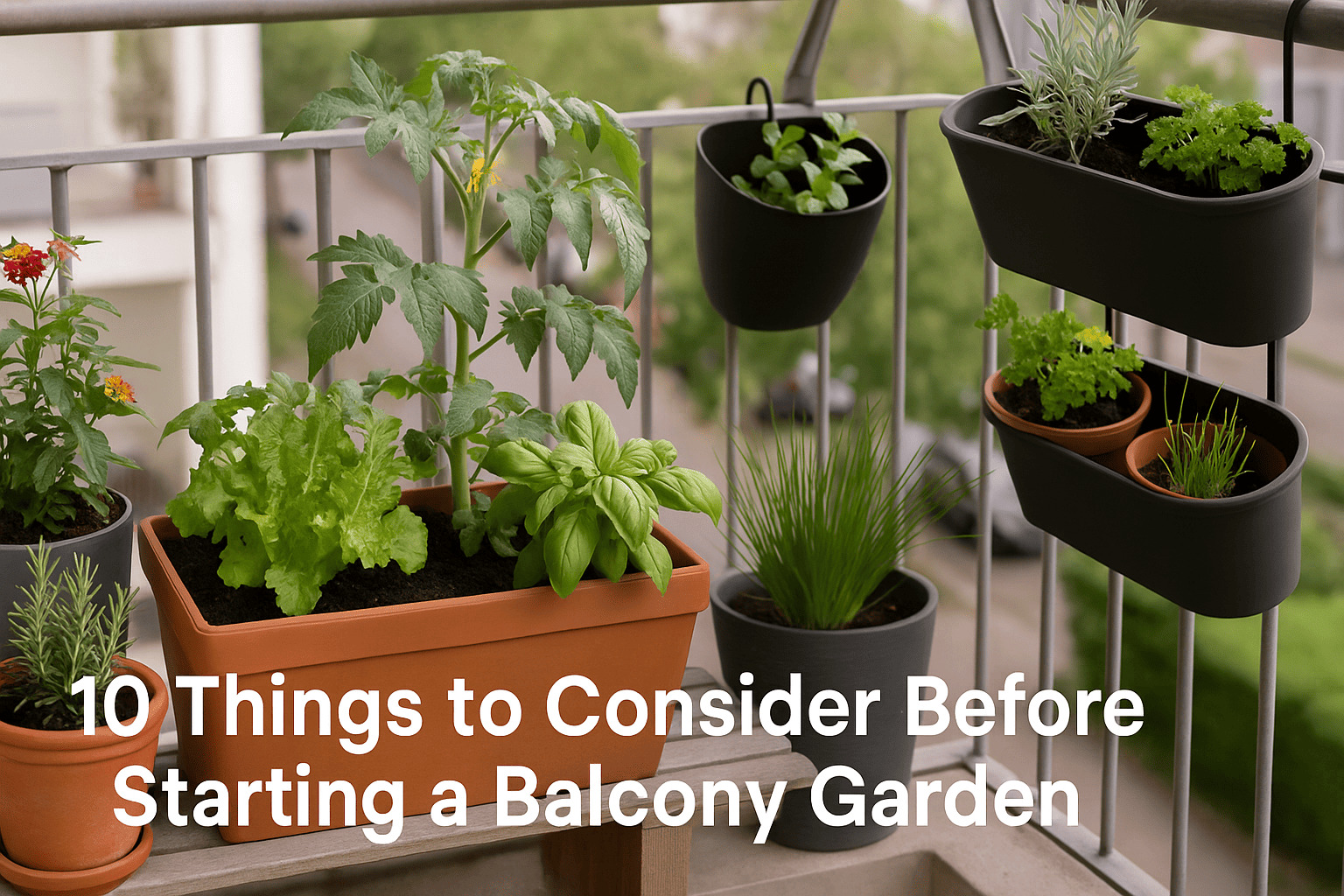
Balcony gardening requires a bit of planning to set you up for success. Think of these as the top 10 things to consider – essentially “questions to ask before starting a balcony garden.”
Addressing these points will help you design a beautiful, productive balcony garden that fits your lifestyle.
Read Also
The Hidden Reasons: How to Fix Common Indoor Plant Problems
The Ultimate Self-Watering Pot Guide: No More Dead Plants Again
1. How Much Sunlight Does Your Balcony Get?
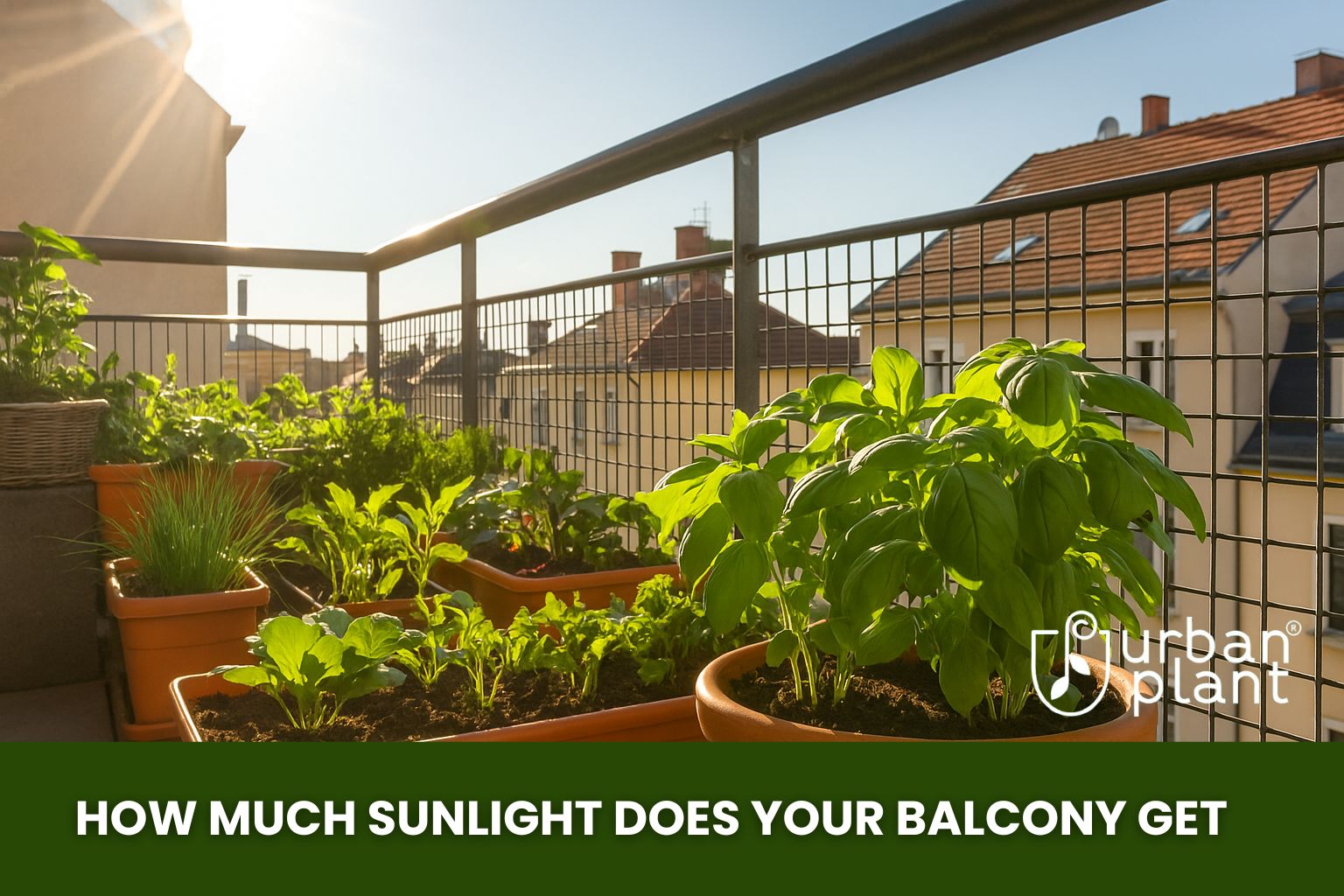
Sunlight is the lifeblood of any garden. Observe your balcony to see how many hours of direct sun it receives and note the times of day.
Most veggies and flowers prefer 6–8 hours of sunlight daily.
An east or south-facing balcony usually gets ample sun, ideal for tomatoes, peppers, or roses.
If you have a shady balcony, don’t worry – you can still grow shade-tolerant plants like lettuce, spinach, ferns, or pothos.
Leafy greens and many herbs can thrive with less sun, making them perfect for low-light conditions.
Use reflective surfaces (mirrors or light-colored walls) to bounce extra light onto plants if needed.
Knowing your sunlight exposure will guide your plant choices and layout.
2. Is Your Balcony Structurally Safe for Gardening?
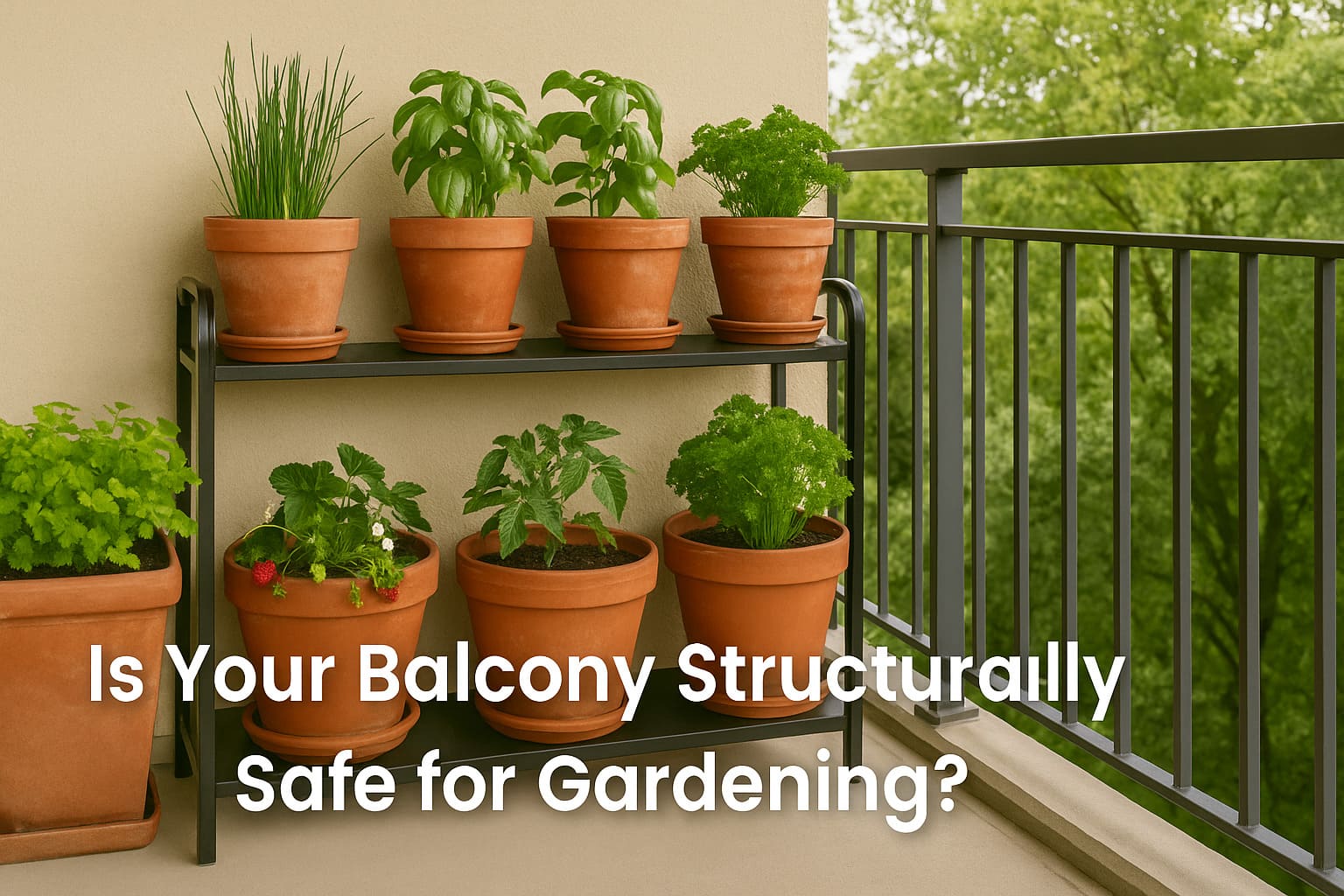
Before hauling in heavy pots, consider your balcony’s weight capacity and rules.
Apartment buildings and housing societies may have restrictions on what you can place on balconies.
Check your building guidelines – some prohibit attaching planters to railings or have weight limits for safety. Wet soil is heavy, and large ceramic pots can add a lot of load.
If in doubt, opt for lighter plastic or fiberglass planters and distribute weight evenly.
It’s also wise to use saucers or trays under pots to catch excess water so it doesn’t drip down (and to prevent any mess on neighbors’ balconies).
Ensuring your balcony can handle your garden’s weight and setup is crucial for safety and peace of mind.
3. How Will You Handle Wind and Weather?
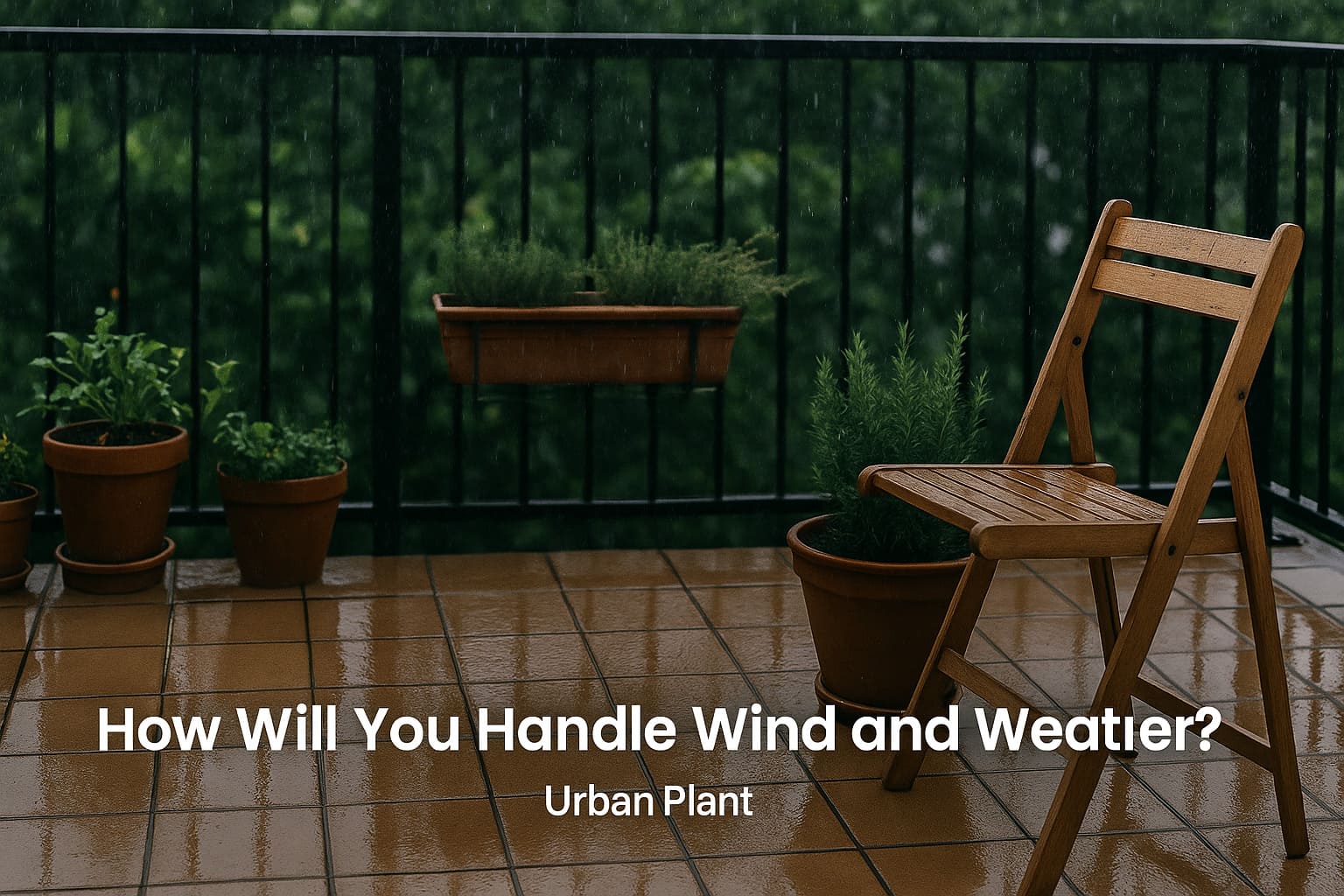
Balconies, especially on higher floors, can be exposed to strong winds and other elements. Wind can dry out soil quickly, batter your plants, or even topple tall pots.
Group heavier pots on the floor and put fragile plants in sheltered corners. Heat is another factor – sun reflecting off windows or walls can create hot spots that scorch leaves.
On the flip side, rain and monsoons can flood pots if drainage is poor. Plan for weather by choosing sturdy, wind-resistant plant varieties and using balconies’ nooks for protection.
In rainy seasons, move sensitive plants closer to the wall or under eaves.
Being mindful of your balcony’s microclimate (wind, heat, humidity) will help your garden thrive through the seasons.
4. Do You Have a Water Source and Drainage Plan?
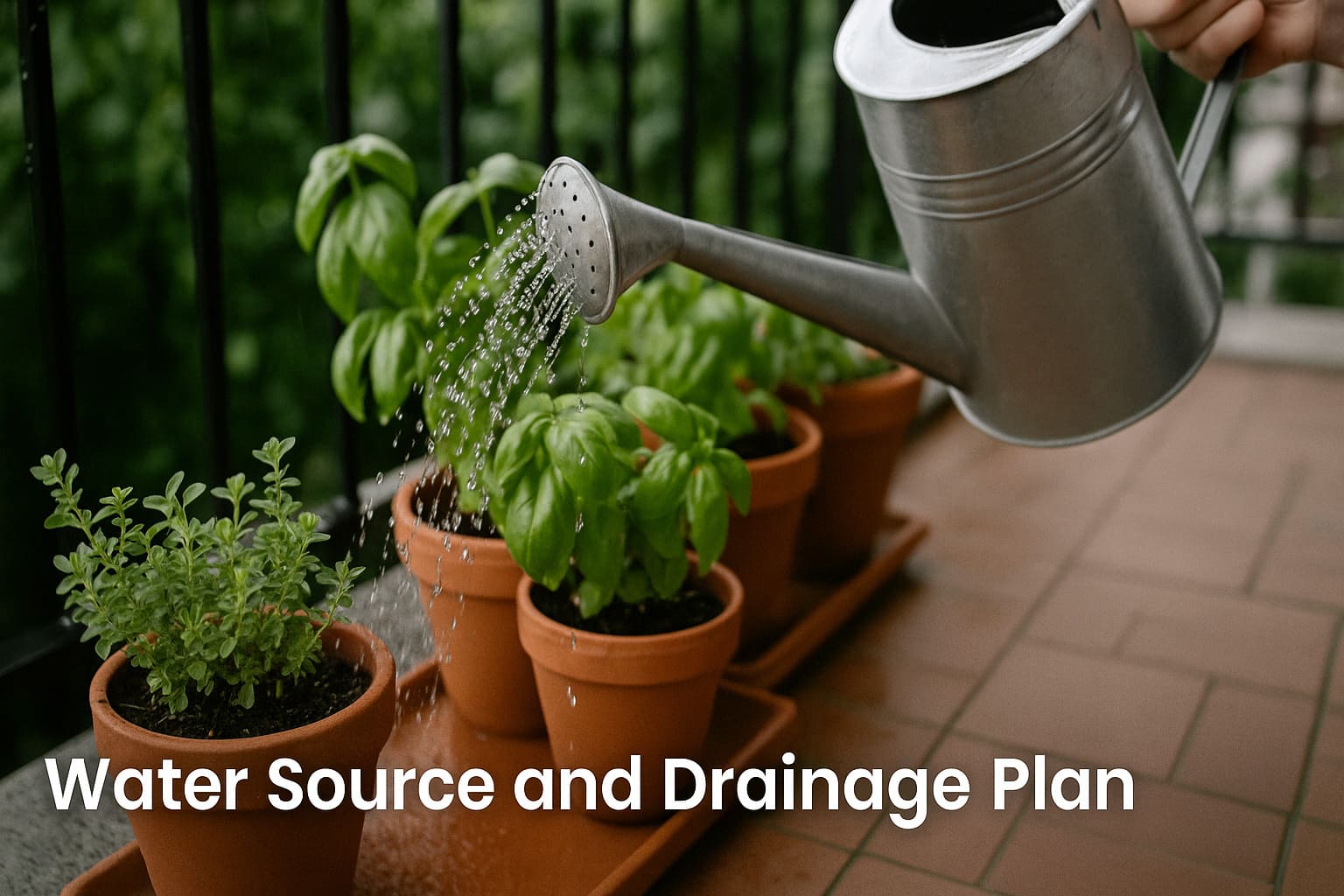
Watering is a key part of gardening, and in small spaces it needs some strategy. Few balcony gardens have a direct water supply, so you’ll likely carry water from your sink or use a watering can.
Plan how you’ll do this. Investing in a lightweight watering can (or a collapsible one that’s easy to store) is a great idea.
Consistency is key: balcony containers can dry out faster than garden beds, especially in heat or wind.
During peak summer, you might need to water once or even twice a day.
If you’re a forgetful waterer or travel often, self-watering pots or a simple drip irrigation setup can be a lifesaver.
They release water slowly and reduce watering frequency. Good watering practices and drainage planning will keep your balcony garden happy and healthy.
5. What Containers and Soil Will You Use?

Choosing the right pots and soil is fundamental to balcony gardening success. Containers come in all shapes and sizes – from classic terracotta pots to plastic planters, hanging baskets, and even repurposed buckets.
For small spaces, go vertical and think creatively (more on that in a bit).
Whatever you choose, make sure your containers are deep enough for your plants’ roots and have those all-important drainage holes.
Lightweight materials like plastic or fabric grow bags are easier on your balcony load than ceramic or stone.
Use a high-quality potting mix (not dense garden soil) which is light and drains well, yet retains moisture. Mixing in compost or an organic fertilizer gives plants a nutrient boost.
Fill your pots with this mix, and top-dress with a little compost every few weeks to replenish nutrients.
A pro tip: consider self-watering pots if you can – these have reservoirs that keep soil moist, making watering easier (great for beginners or busy gardeners). With the right container and soil combo, your plants’ roots will have the perfect home.
6. What Plants Are Best for Your Balcony?
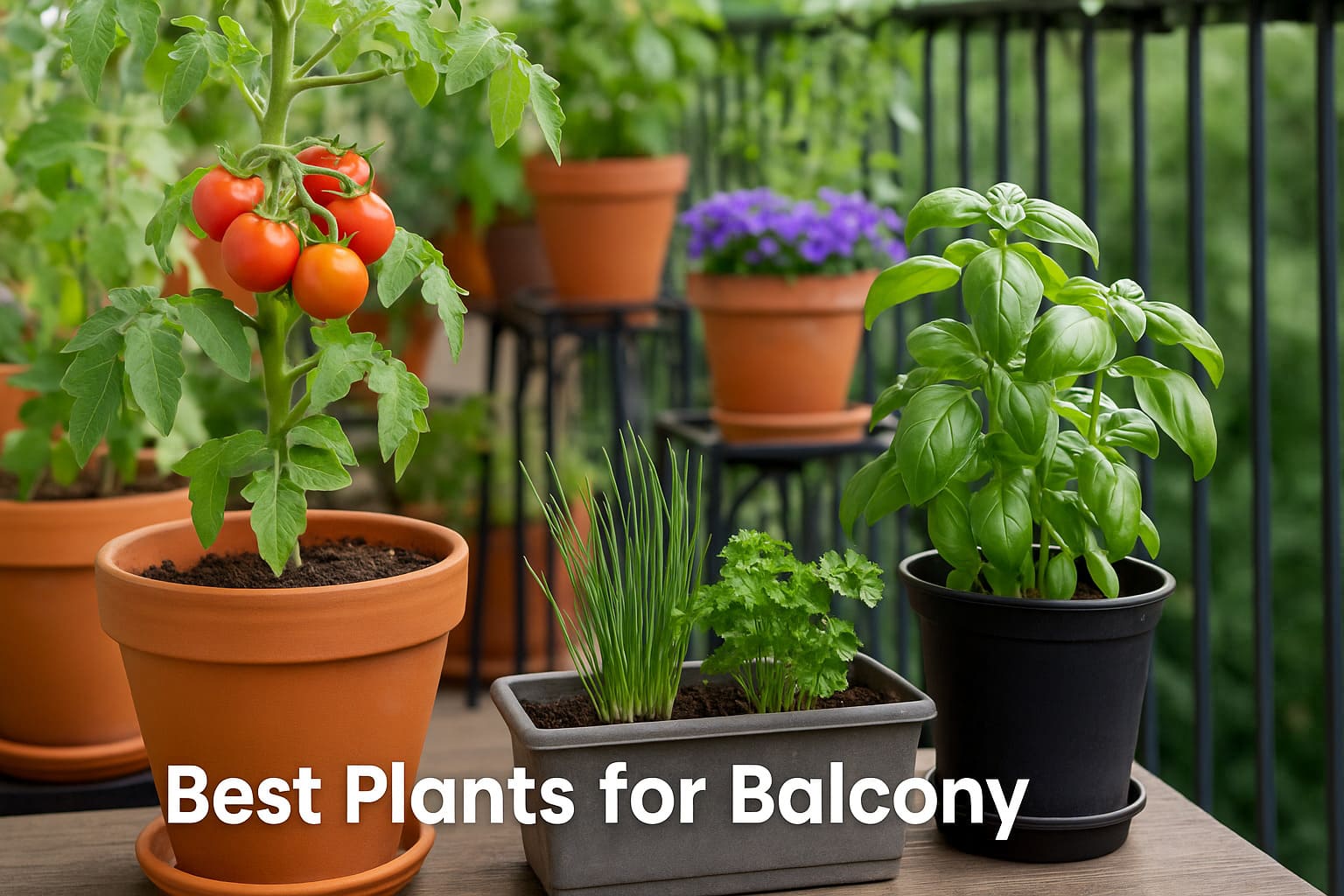
One of the most exciting parts of balcony gardening is choosing what to grow.
The possibilities are vast – from herbs and flowers to veggies and even dwarf fruit trees.
Start by assessing your conditions (sun, space, climate) and then opt for suitable, easy-to-grow plants.
For an easy balcony gardening for beginners approach, it’s wise to pick low-maintenance yet rewarding plants.
Herbs like basil, mint, coriander (cilantro), and thyme are excellent – they stay compact, grow well in pots, and you can use them in the kitchen.
Leafy greens (lettuce, spinach, fenugreek) do great even with partial sun.
If you have good sunlight, try cherry tomatoes, green chilies, or peppers – these are among the easiest veggies to grow in containers.
You can even grow a Balcony Vegetable Garden (India) style by including Indian staples: a curry leaf plant, a small pot of chili pepper, or a lemongrass clump.
Remember to consider your local climate – for instance, in a hot city like Lucknow you might grow sun-loving marigolds or okra, whereas a cooler Bangalore balcony could host lettuce and strawberries.
7. How Can You Maximize Your Small Space?
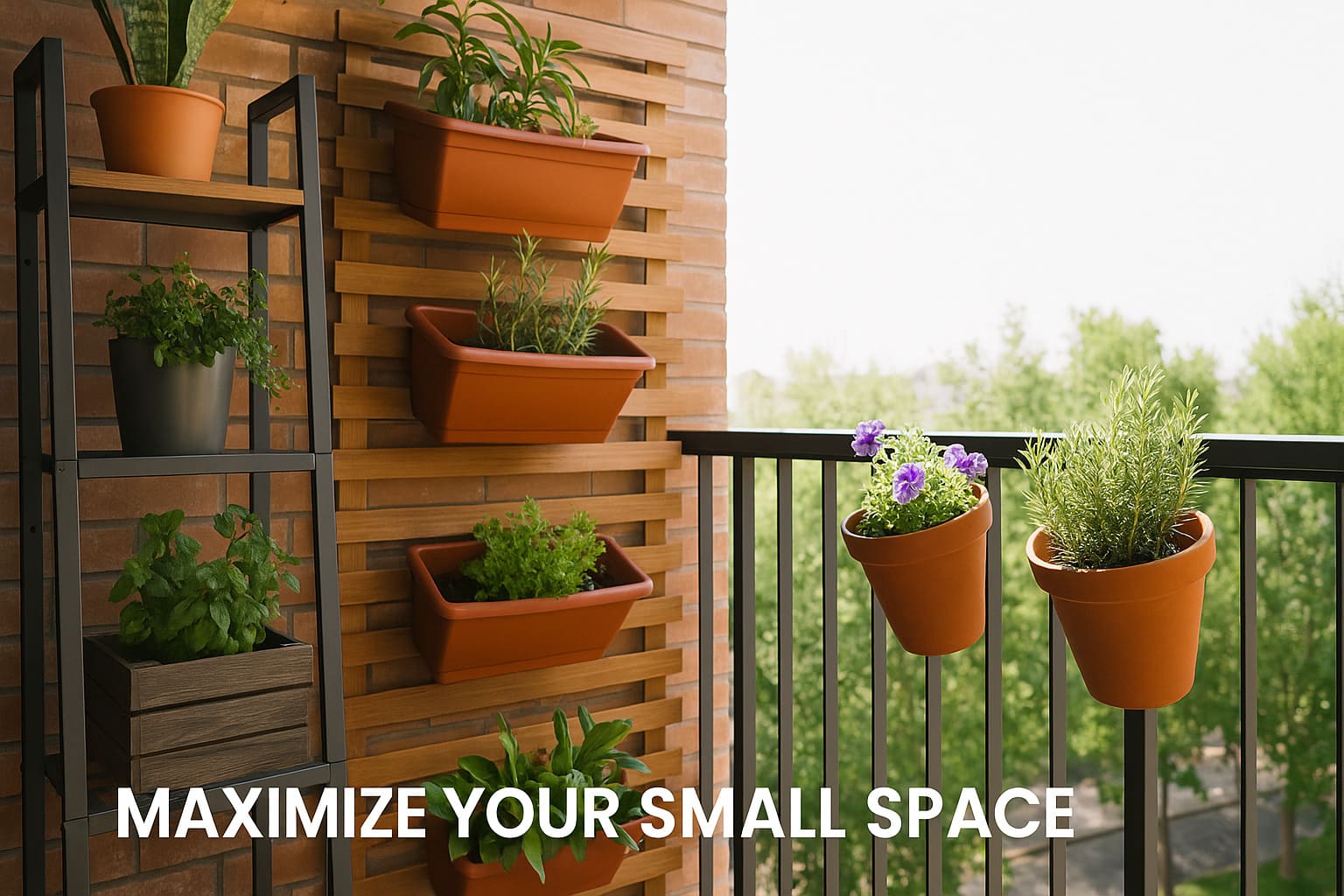
When space is at a premium, think vertical and multi-purpose.
One of the top Balcony Garden Ideas is to use vertical space cleverly: install wall-mounted planters, hanging baskets, or railing planters to free up floor area.
For example, you can attach pots or a trellis to your balcony walls and grow climbing plants like beans or morning glories upward instead of outward.
Shelves and plant stands (tiered stands) allow you to stack more plants in a corner. (Urban Plant offers stand planters and hanging planters designed to help utilize every corner, from floor stands to railing hooks.
Consider a vertical garden unit or even DIY one using an old bookshelf or ladder as a plant rack.
Use your railing: rail planters that hook onto the balcony railing are fantastic for trailing flowers, strawberries, or even a row of salad greens.
By making use of vertical space and smart layouts, even a tiny balcony or a window grill can turn into a personal green haven.
8. How Much Time Can You Commit to Maintenance?
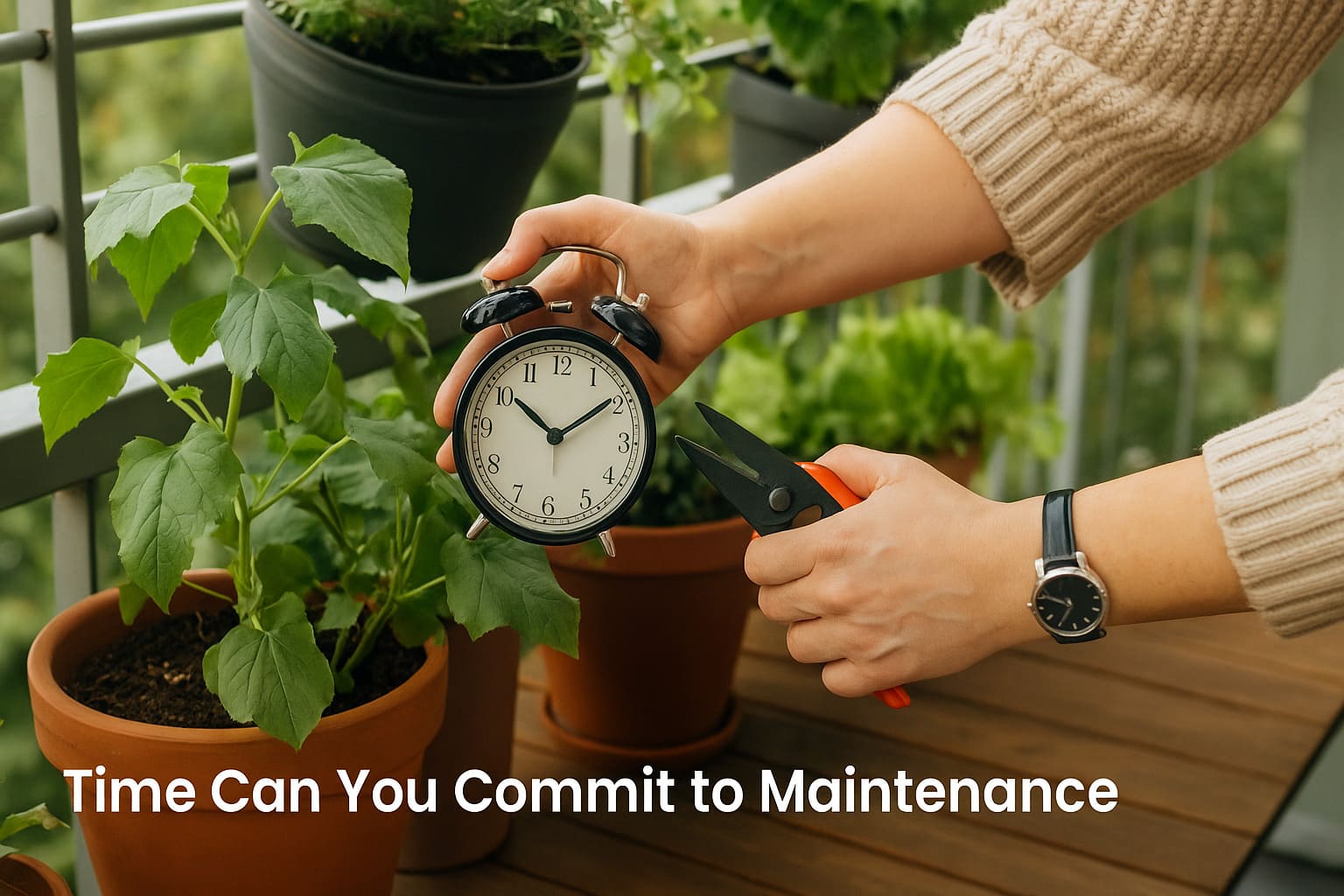
Be honest with yourself about the level of care you can provide – this will inform how you set up your balcony garden. If you travel frequently or have a busy schedule, opt for a low-maintenance setup.
Choose hardy plants that can tolerate a bit of neglect – succulents, snake plants, pothos, or rosemary are pretty forgiving.
For edible plants, go with tough herbs (like lemongrass or oregano) and cherry tomatoes or chillies which don’t mind occasional dry spells.
Using self-watering pots, irrigation spikes, or wicking systems can dramatically reduce how often you need to water.
Also consider grouping plants by their care needs – for example, keep high-water-needs plants together (so you can water that corner more) and drought-tolerant ones separately.
Regular tasks include watering, feeding, pruning, and checking for pests.
If you can spare even 15–20 minutes a day to tend your balcony garden (or a slightly longer session on weekends), you’ll find it sufficient for most small gardens.
Many urban gardeners find that this daily routine becomes a relaxing ritual rather than a chore
Balcony gardening should relieve stress, not add to it – set it up in a way that suits your lifestyle.
9. Are You Prepared for Pests and Other Challenges?
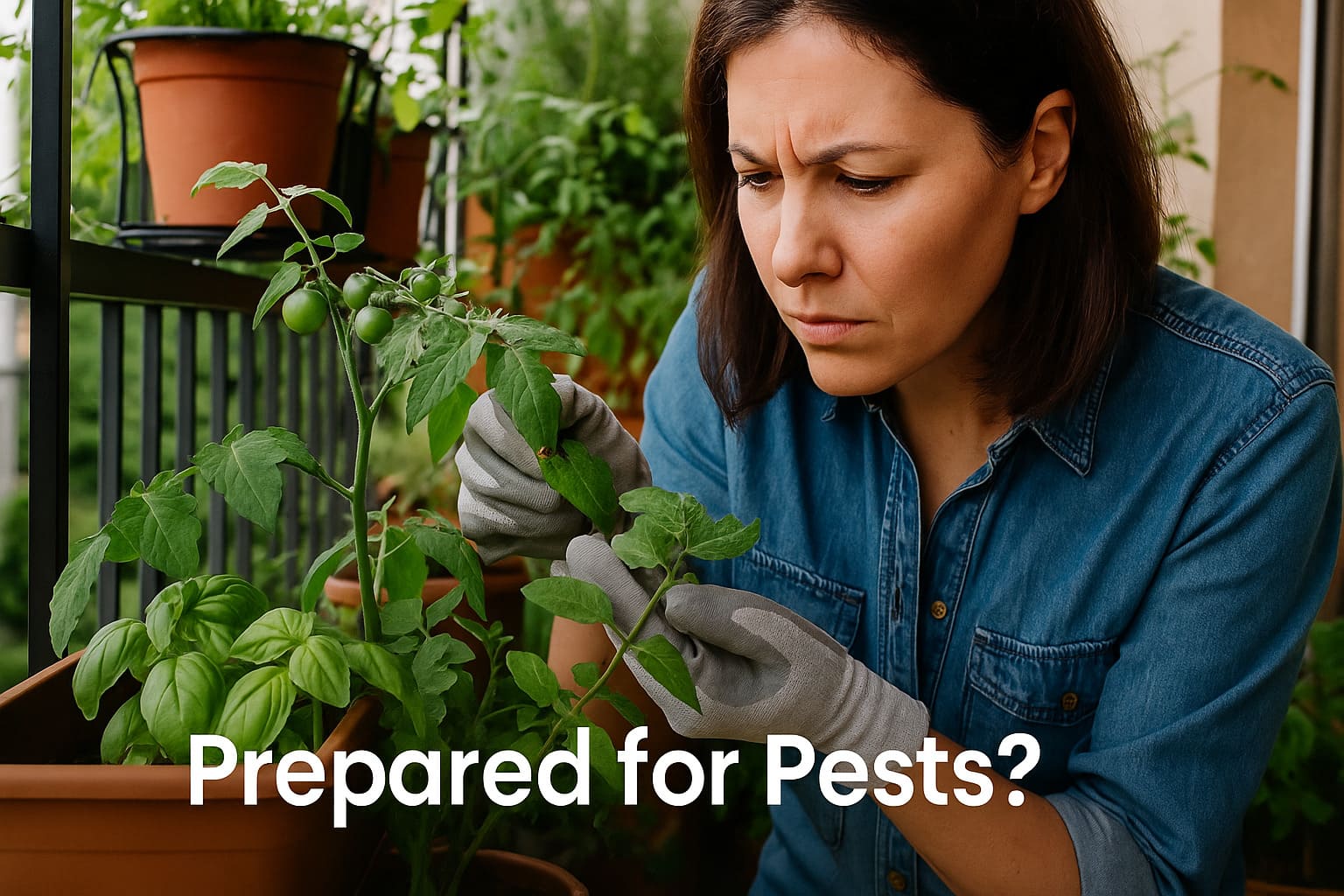
Tiny gardens can attract tiny troubles. Common balcony garden pests include aphids, mealybugs, caterpillars, or whiteflies that might munch on your plants.
You might also contend with mosquitoes breeding in water trays if you’re not careful, or pigeons who think your planters are their personal salad bar!
The key is preventive care and gentle intervention.
Keep an eye on your plants – a quick daily scan of leaves will catch problems early. If you spot pests, try organic remedies first.
For example, neem oil sprays or soap solution can help with many insects.
You can also plant natural pest-repellent herbs among your crops: basil, mint, marigolds, and rosemary tend to deter pests like aphids and mosquitoes with their strong scents.
If you get fungus or mildew (common in humid seasons), ensure better air flow and use organic fungicide if needed.
For mosquitoes, make sure no water sits stagnant in trays – empty saucers after watering. If birds are a nuisance, lightweight netting can protect your edible plants.
Instead, stick to eco-friendly solutions – for instance, Urban Plant’s Organic Pest Controller spray is a safe option for edible gardens.
10. What’s Your Plan for Style and Enjoyment?
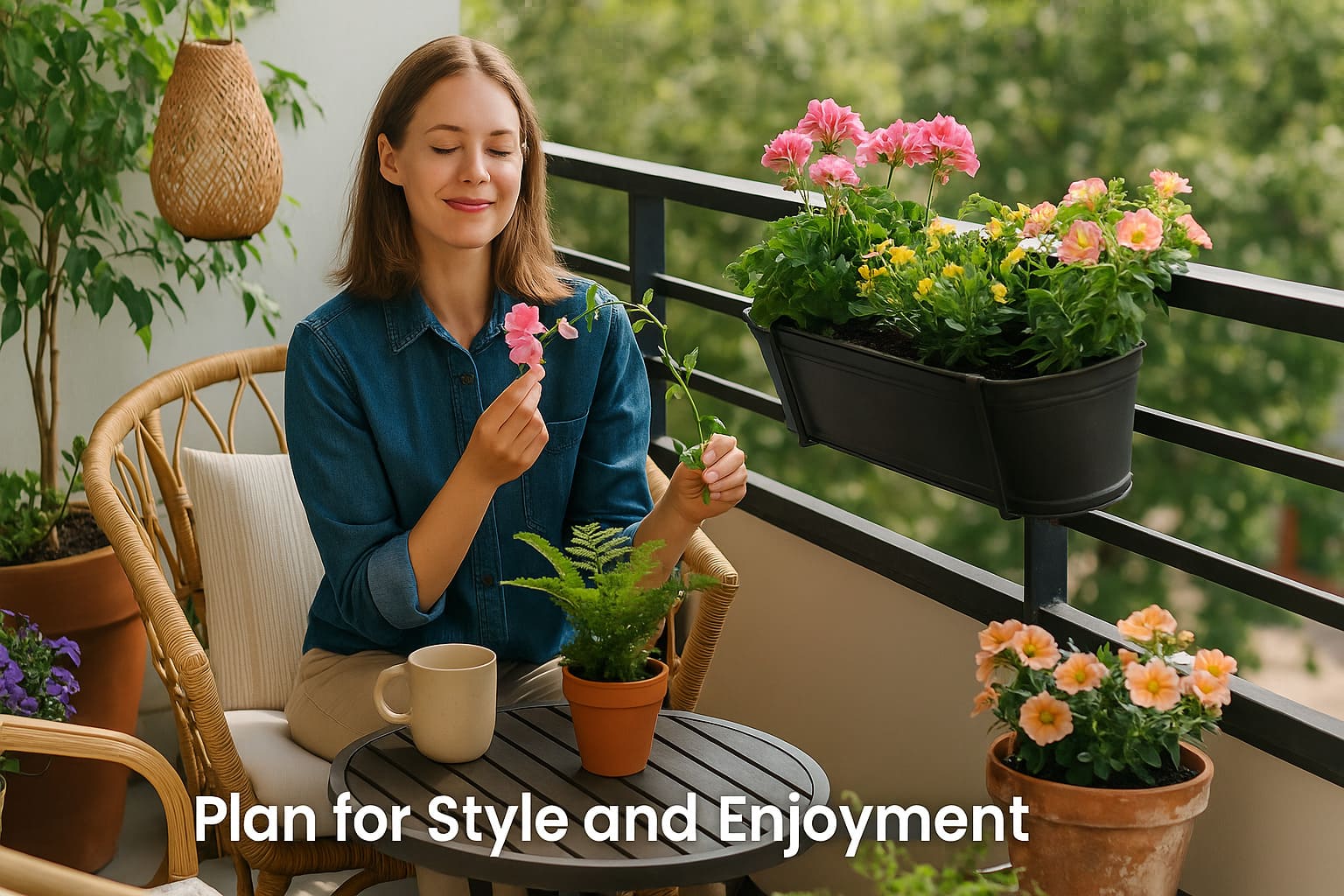
Finally, consider what you want from your balcony garden. Is it a functional kitchen garden for veggies and herbs, a flowering paradise for visual delight, or a cozy green nook for your morning tea?
Plan your design and plant selection around your goals. If you love flowers, incorporate colorful ornamental plants like petunias, bougainvillea, or geraniums in railing planters (instant curb appeal!).
If relaxation is the aim, add a small chair or floor cushion among your pots to create a mini oasis.
Think about garden décor: string lights, a small water feature or fountain, or garden statues can elevate the ambiance.
You can even hang some wall planters with trailing ivy to frame a nice background.
Gardening trends for small spaces currently favor lush, jungle-like balconies with lots of foliage, as well as smart tech like app-connected drip irrigation for convenience.
But ultimately, the best trend is what brings you joy.
By infusing your own style and creativity, you’ll create a balcony garden that not only looks good but also uplifts your daily life.
Now that we’ve covered the key considerations and Balcony Gardening Tips, you should be feeling more confident about starting your own balcony garden.
To wrap up, let’s address some of the top questions new balcony gardeners often ask:
Frequently Asked Questions (FAQs)
1. What are the best tips for balcony gardening in small spaces?
The best balcony gardening tips include using vertical planters, choosing compact or dwarf plants, ensuring proper drainage, and grouping plants based on sunlight needs. Start with low-maintenance herbs and veggies like basil, mint, or spinach. Always assess sunlight, use lightweight containers, and opt for organic soil mixes.
2. Can I grow vegetables on my apartment balcony in India?
Yes, you can easily grow vegetables like tomatoes, chillies, spinach, fenugreek, and coriander on your balcony in India. Choose containers with drainage holes, ensure 4–6 hours of sunlight, and use organic fertilizers for the best results.
3. How much sunlight do balcony plants need?
Most balcony plants need at least 4 to 6 hours of direct sunlight daily. Leafy greens and some herbs can tolerate partial sunlight, while fruiting vegetables like tomatoes need full sun to thrive.
4. What are the easiest plants to grow on a balcony?
The easiest plants for balcony gardening are mint, basil, spinach, aloe vera, coriander, and cherry tomatoes. These plants are beginner-friendly, low-maintenance, and grow well in pots.
5. What containers are best for balcony gardening?
Fabric grow bags, plastic pots, and railing planters are best for balcony gardening. They are lightweight, durable, and ideal for limited space. Ensure all containers have good drainage to prevent root rot.
6. How do I water balcony plants properly?
Water balcony plants in the early morning or evening. Use self-watering pots or watering cans for convenience. During summer, daily watering may be needed; in winter, water less frequently based on soil moisture.
7. What are common problems with balcony gardening?
Common balcony gardening issues include overwatering, poor drainage, pest infestations, and wind damage. These can be solved by using proper containers, organic pest sprays, and weather protection like bamboo screens or shade nets.
8. How do I protect balcony plants from heavy rain and strong winds?
Use windbreakers like bamboo fencing, transparent sheets, or netting. Move delicate plants closer to walls or under covered areas during heavy rain. Group pots together to stabilize them.
9. Is balcony gardening expensive to start?
Not at all. Balcony gardening can be budget-friendly using recycled containers, kitchen waste compost, and beginner gardening kits from brands like Urban Plant. Start small and scale up gradually.
10. What should I consider before starting a balcony garden?
Key things to consider include sunlight exposure, balcony weight limit, wind protection, drainage setup, plant selection, and your available time for maintenance. Having a plan before planting helps avoid common mistakes.




